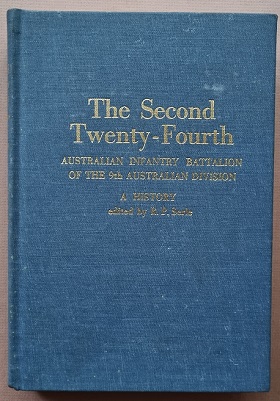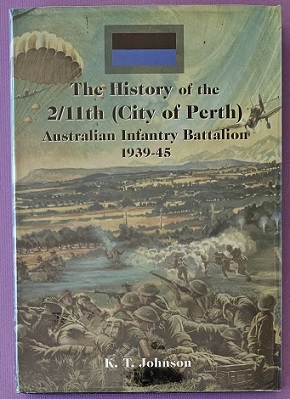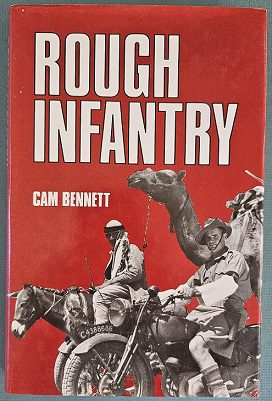Description
Title: The Second Twenty-Fourth Australian Infantry Battalion of the 9th Australian Division: A History.
Author: Serle, R P
Condition: Very Good +
Edition: 2nd Edition
Publication Date: 1980
ISBN: N/A
Cover: Hard Cover without (missing) Dust Jacket – 378 pages
Comments: The story of the 2/24th Infantry Battalion during World War 2.
Victoria’s 2/24th Infantry Battalion was raised in Wangaratta in July 1940. It was part of the 26th Brigade, with the 2/23rd and 2/48th Battalions. The brigade was initially part of the 7th Division but in early 1941 became part of the 9th Division. The 2/24th trained at Bonegilla before sailing for the Middle East in November.
In early 1941 the 26th Brigade, along with the rest of the 9th Division, moved into Cyrenica to complete its training. However, despite the successes of the British offensive at the start of the year, when the German Afrika Korps led the Axis counter-attack the 9th Division fell back to the Tobruk – colloquially referred to as the “Benghazi handicap”. The 2/24th entered Tobruk on 10 April and helped defend the “fortress” for the next eight months.
The 2/24th saw extensive service at Tobruk, manning the Red Line at a number of different locations and participating in the bitter fighting in the Salient. The Red Line was Tobruk’s outer line of defence and consisted of a series of concrete pillboxes forming a semi-circle around the town. In October the majority of the 9th Division, except the 2/13th Infantry Battalion, was evacuated by sea. The 2/24th was evacuated on the night of 20 October, sailing to Alexandria. The division was transferred to Palestine and Syria for rest and garrison duties.
By July 1942 German and Italian forces had reached El Alamein in Egypt, about seventy miles from Alexandra. The war in North Africa had become critical for the British Eighth Army. The 9th Division was consequently rushed from Syria to the Alamein area and held the northern sector for almost four months as the Eighth Army was reinforced for an offensive under new a commander.
The division’s orders for the first attack were issued on 7 July. The 26th Brigade advanced along the coast, driving a wedge between the sea and German positions by capturing the feature known as Tel el Eise, which ran north-west between the railway line and the sea. During the main offensive from 23 October to 4 November, the 26th and, further south, the 20th Brigade, crossed the Australian start line south of Tel el Eisa. In a sweeping arc, using Trig 29 as the pivot point, the brigades moved through the Fig Orchard, Thompson’s Post, and numerous German mine fields, towards the sea. The heaviest fighting took place at the “Saucer”. By the end of the October the 26th Brigade had suffered heavy casualties and, in what was a bold move, disengaged from the fighting on the night of 31 October, successfully relieved by the 24th Brigade.
Alamein was a great, although bloody, success for the Allies and by 6 November Axis forces were retreating. But the 9th Division was needed elsewhere and with the battle over it returned to Australia to face a new enemy – the Japanese. The 2/24th left Alamein during the first week of December and went to Gaza in Palestine, where it participated in the 9th Division parade on 22 December. The battalion left its camp in Palestine on 23 January 1943 for the Suez Canal and the return voyage to Australia. It reached Melbourne on 25 February.
Reorganised for jungle operations, on 4 September the 2/24th participated in the division’s amphibious landing at Red Beach, north-west of Lae. After fighting in the battles around Lae, Finschhafen, and Sattelberg, the battalion returned to Australia in March 1944.
After some leave, the 2/24th reformed in Queensland at Ravenshoe on the Atherton Tablelands, for what proved to be an extensive training period. Indeed the war was almost over before the battalion went into action again.
In April the 9th Division was transported to Morotai, which was being used as a staging in area in preparation for the 7th and 9th Divisions amphibious landings on Borneo. The 26th Brigade landed on Tarakan on 1 May. The two lead battalions were the 2/48th and 2/23rd, while the 2/24th was in reserve. After the massive pre-invasion air and naval bombardment, there was no opposition on the beaches but sharp Japanese fire came from Lingkas Hill. The two battalions pushed inland towards the Tarakan township, overcoming Japanese resistance as they went. By nightfall they had established a beachhead 2.5 km wide and 2 km deep. Almost all objectives had been taken but the Japanese on the position called “metho” held out a little longer. The 2/24th was ordered to push through and capture the airfield the next day. However, the Japanese stubbornly fought back and the airfield was not taken until 5 May. Tougher fighting was still to come.
From 6 May to 16 June the mountain ridges behind the town were the scene of difficult fighting. In the area of tangled hills and jungle-covered ridges, the Japanese used mines, booby traps, and suicide raids to delay the Australian advance. The 2/24th fought along Crazy Ridge. On 20 June it captured the Australians’ last main objective, Hill 90, after the hill had been hit by 21,000 artillery rounds and 600 mortar bombs.
With Hill 90’s capture, the fighting on Tarakan was all but over. The island was divided into areas, which each unit had to clear any remaining Japanese survivors. The 2/24th sector was the northern part of the island, covering the Juata Oilfields with the 2/4th Commando Squadron and some Dutch troops.
Following the end of the war in August and Japan’s surrender, the ranks of the 2/24th thinned, as men were discharged, transferred, or volunteered for the occupation force for Japan. Those who remained in the battalion returned to Australia in December. The 2/24th disbanded at Puckapunyal in early 1946.
Includes Roll of honour





